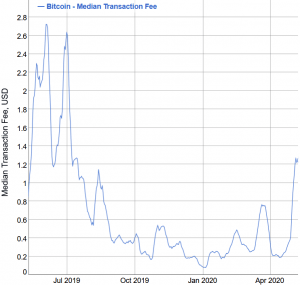Is Bitcoin’s Lightning Network Ready to Replace Altcoin Use Cases?
For many, Bitcoin’s (BTC’s) Lightning Network (LN) is viewed as a way for the world’s most popular cryptocurrency to enable faster, cheaper payments. While many altcoins, such as Bitcoin Cash (BCH) and Litecoin (LTC), have specifically focused on low transaction fees for smaller cryptocurrency payments, the idea with the LN is to enable this functionality for the world’s most widely-used and liquid cryptocurrency— removing the need to create an alternative cryptocurrency network with a new token.

Defining how long the Lightning Network has been around depends on one’s definition of the true launch date of the second-layer payments protocol, but Lightning-enabled bitcoin wallets have been available for a few years now. So, has the LN replaced the need for altcoins focused on lower transaction fees? Let’s take a closer look.
Lightning Network for online retail payments
In January 2019, it was reported that Bitrefill, which sells gift cards and mobile prepaid cards as part of its business, had already seen the LN overtake all of the individual altcoins in terms of payments.
Since then, it has mostly been ethereum (ETH), not the Lightning Network, that has seen some growth relative to other payment options on the platform. According to Bitrefill CEO Sergej Kotliar, the cryptocurrency payments breakdown for the online retailer is currently as follows:
- 80% on-chain BTC,
- 7.5% ethereum (ETH),
- 4% Lightning-based BTC,
- 7.5% other altcoins LTC, dash (DASH), and dogecoin (DOGE)).
“Everything is growing, but in share, Lightning is currently not growing at [the] expense of other payment methods,” Kotliar told Cryptonews.com.
It should be noted that this data is in reference to payments made by users that do not have refillable accounts on Bitrefill, where only bitcoin transactions (on chain or Lightning) are accepted.
“We’re still optimistic about Lightning, especially as we’re seeing usage of everything grow right now, and the possibilities especially of integrations with custodial entities, such as what we’ve done with Bitfinex,” added Kotliar. “But adoption among exchanges is going slowly. I would have expected more by now. Maybe with more fee pressure it will pressure more of them to add Lightning.”
Lightning Network for online gambling
Online gambling platform Bitkong shared somewhat similar numbers with Cryptonews.com. According to a Bitkong spokesperson, the current usage breakdown of their available payment options is as follows:
- 88% on-chain BTC,
- 4% ETH,
- 3% XRP,
- 2% BTC via Lightning,
- 2% DOGE,
- 1% LTC.
“Recently we delisted [BCH] as no one used it,” added the Bitkong spokesperson. “[It didn’t even] cover node hosting costs.”
Bitkong will also be removing DASH as a payment option soon, as basically none of their users make their deposits or withdrawals via that cryptocurrency.
“We are trying to educate as many players as we can to switch to Lightning wallets,” said the Bitkong spokesperson. “This [has] huge benefits for both sides, as deposits are instant and secure (unlike most altcoins).”
According to Bitkong, pretty much all of the growth in Lightning Network usage from their users has taken place rather recently.
“We have seen growth only [in the] last three months,” said the spokesperson. “Past year usage was almost none. Reasons can be that we started some Lightning-oriented marketing (like listing at LightningNetworkStores.com) or its growing overall and many users becoming familiar with the network.”
Some are still waiting
While Bitrefill and Bitkong have been accepting Lightning-based BTC payments for quite some time, other major players in the cryptocurrency space are still taking a wait-and-see approach.
“We are watching the Bitcoin Lightning development with great interest,” Purse’s Eduardo Gomez told Cryptonews.com. “The reason why we haven’t included it is that the transaction [size] limit of the Lightning Network is not quite there yet for the kind of volume we see in our platform (at least the last time we checked that was the case). We are also looking forward to the inclusion of SIGHASH_NOINPUT to make the transactions safer.”
SIGHASH_NOINPUT is a soft-forking addition to the Bitcoin protocol that would enable an efficient implementation of a reimagined version of the Lightning Network, known as eltoo (PDF).
Purse users are able to make deposits and withdrawals via BTC and BCH. While Gomez did not share specific data regarding how often each option is used, he stated, “BTC is by far the most popular currency in our platform.”
Bitcoin’s median on-chain transaction fee has risen from below USD 0.20 to more than USD 1.00 over the past month.

If this rise in fees continues, we may eventually get a clearer picture as to whether the Lightning Network’s is replacing the supposed utility of low-fee altcoins.




